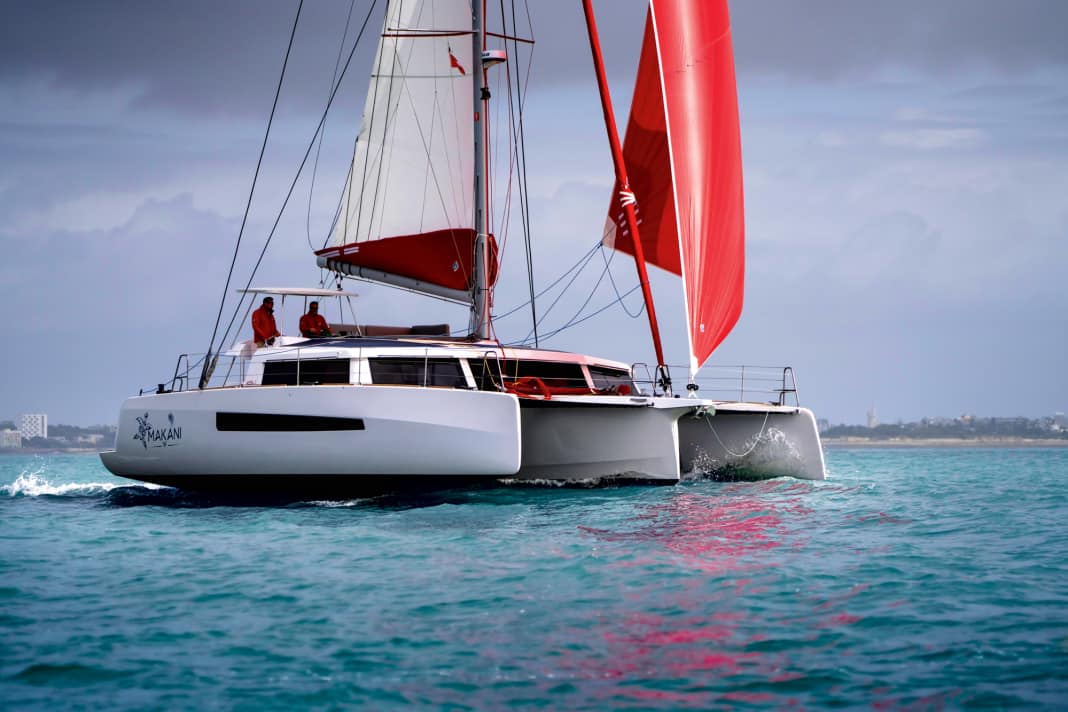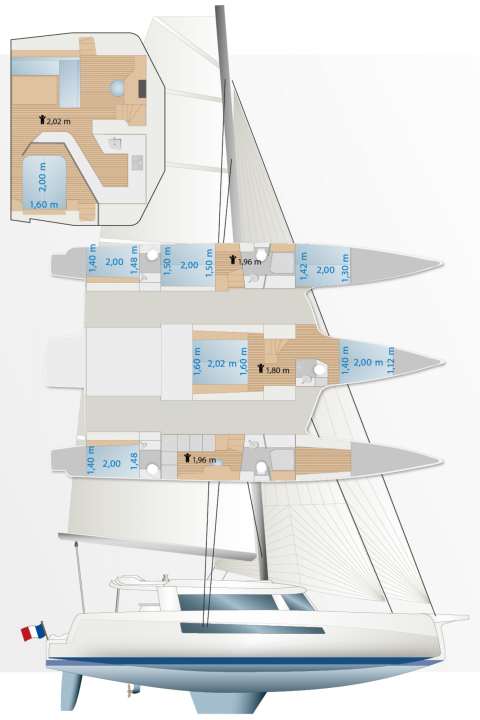





More living space on and in three hulls, plus the technical sailing advantages of a trimaran compared to a conventional catamaran. These are arguments that can also be combined, according to the original guiding principle of Eric Bruneel, founder, innovative mind and at least partial namesake behind the Neel Trimarans brand. Over the years, the shipyard in La Rochelle has expanded its special concept and continuously optimised it with intensive model maintenance. On top of this, new production capacities have been established time and again. Today, the shipyard builds around 30 to 35 trimarans a year and has thus become a respectable competitor for the established multihull brands.
Also interesting:
Following its rapid success, Eric Bruneel has now handed his company over to other hands and only works in the background as a consultant. The Neel 52 is now the first completely newly developed boat under the new management and is the successor to the Neel 51, which was awarded the title of European Yacht of the Year in 2018 for its innovative concept. The 51, a Joubert/Nivelt design, was the first trimaran of its kind with interior fittings for living in the side hulls.
The design of the new 52 now comes from the studio of Marc Lombard Yacht Design. The slender side hulls are slightly shorter than the central hull, but have a deep underwater hull with a pronounced bulge. The designers want to ensure that the trimaran is stable on all three hulls when neutrally afloat in the harbour and does not tip sideways, as is often the case with racing trimarans. At the same time, the waterline should remain as short as possible and thus the wetted surface as small as possible. Under sail, the geometry is designed in such a way that the boat always heels slightly in the wind, so that the float remains permanently on the water upwind.
The Neel 52 sails lively and dynamic on the mainsheet
This has already been shown in other tests with Neel's boats: Trimarans move differently in the waves than twin-hull boats. The rolling motion that is often typical of catamarans is less pronounced and the boat also pitches less in the waves. This is due to the fact that the centre of buoyancy and centre of gravity are closer together on boats with three hulls than on conventional catamarans. The more centred the centre of gravity is in general, the smoother and more balanced the boat sails and the greater the comfort underway.
With the large genoa (115 per cent overlap) and battened square top, the Neel 52 achieved a ground speed of 6.4 knots in light winds of just three forces. However, the turning angle of 120 degrees is rather sobering in these conditions. The Neel 52 can be steered higher, but with painful losses on the log. You have to steer through the tacks quickly because the boat, with its three hulls, stops fairly quickly when tacking. On the other hand, the trimaran sails lively and dynamically on the courses on the beam and especially with the additionally available gennaker or code zero. Despite having three hulls, the design only provides for one large rudder blade on the centre hull. This allows the boat to be steered actively and with a lot of feeling and also makes it responsive.
The helm cockpit is attached to the side and offers generous space for up to three people, who hardly get in each other's way when manoeuvring. All sheets, halyards and trim lines are fed back into the working area via the coachroof to three large and powerful winches, all of which can also be operated electrically. From the helm station, three steps lead up to the flybridge with its cosy sun lounge.
Enormous amount of space in the interior
A tour of the interior on Neel's large trimaran is an exciting journey of discovery and experience. In the saloon, the enormous volume of available space is surprising. The layout is very special because it is hardly comparable. Essentially, the individual living and functional areas are distributed over one continuous level, similar to a loft flat. Only the spacious owner's cabin on the starboard side is completely partitioned off, although it remains visually connected to the saloon thanks to a long row of windows. Curtains and blinds provide privacy if required.
However, the very generously proportioned cabin only takes up around a quarter of the floor space. This leaves enough space for an unusually large and almost fully enclosed galley as well as a generous seating area aft. The navigation is built directly against the window front of the saloon. Those working here enjoy an almost unrestricted view forwards, to the sides and into the sails and can also steer the boat from inside in bad weather using the remote control of the autopilot.
Customers can also choose from a wide range of options for the layout in the side hulls. The standard layout is with two double cabins and a central wet room with shower area. However, depending on requirements, the cabins can also be converted into an office, workshop or utility room with washing machine. In addition, aft cabins with their own toilet for the skipper(s) are possible. Another central double cabin is provided in the centre hull below the saloon, virtually in the basement. However, this windowless room remains dark and therefore rather uncomfortable. But there are also possibilities for alternative use here, for example as a huge walk-in storage space.
Expensive in comparison
A hatch in the cockpit floor under the raised steering position provides access to the large technical room at the rear of the centre hull. There is space here for all technical installations such as the boiler, water maker and batteries. In the centre, the powerful 110 hp four-cylinder engine is largely free-standing and is therefore easily accessible for inspection and repairs. In contrast to the catamaran with two separate built-in engines, the Neel 52 with only one engine in the central hull has clear disadvantages when manoeuvring and parking in the harbour. The bow thruster is therefore an essential piece of basic equipment and is fitted as standard from the shipyard. A second thruster in the stern proves to be a valuable aid when mooring sideways, but is only available as an option for an additional charge.
A buyer must be able to afford a good 1.5 million euros gross for a Neel 52. That's a lot of money, even compared to competitors from the range of series catamarans of a comparable size, which are somewhat cheaper with basic prices of between 1.1 and 1.3 million euros. However, when assessing the costs, the solid construction of all parts using the vacuum infusion process and the high-quality and extensive basic equipment must also be included in the calculation.
The shipyard in La Rochelle builds all parts of its trimarans as sandwich constructions using the complex but weight-saving vacuum infusion process. Since the Market launch of the Neel 43 (test 18/2021) the shipyard has now also changed the materials used and is focussing on ecologically sustainable alternatives. Wherever possible, the components for all of the brand's boats are now built with flax fibres instead of glass fibres and natural cork or foam panels made from recycled PET are used as the core material. All three hulls have a crash box in the bow and are also sealed off several times. According to the brand philosophy, a Neel trimaran should always remain unsinkable under all circumstances. This should minimise the fear of a broken rudder or an orca attack.
Even after almost 15 years on the market, the Neel brand seems to continue to claim the niche of pure cruising boats on three hulls exclusively for itself. Anyone interested in the class of large multihulls around 50 feet in length should definitely consider the three-hull alternative. The comparison is exciting and worthwhile.
The measured values for testing the Neel 52



The Neel 52 in detail

Technical data of the Neel 52
- Designer: Marc Lombard
- CE design category: A
- Torso length: 15,98 m
- Waterline length: 15,98 m
- Width: 8,80 m
- Depth: 1,90 m
- Mast height above WL: 24,1 m
- Theoretical torso speed: 9.7 kn
- Weight: 13,5 t
- Mainsail: 95,0 m2
- Stagfock: 32,0 m2
- Furling genoa: 71,0 m2
- Gennaker: 180,0 m2
- machine (Yanmar): 81 kW/110 hp
- Fuel tank: 780 l
- Fresh water tank: 500 l
- Holding tanks: 3 x 50 litres
Hull and deck construction
Sandwich constructions with GRP and flax fibres as well as a PET foam core. All parts of the hull and deck are constructed using vacuum infusion
Rig in two sizes
The aluminium rig with stainless steel shrouds is standard. The performance rig features a 70 centimetre higher carbon fibre mast with textile shrouds. In the package with high-quality sails, the performance upgrade costs around 167,000 euros (gross) extra
Motorisation
The four-cylinder built-in diesel engine from Yanmar with Saildrive propulsion is installed in the centre hull. A bow thruster (24 V) is also included as standard
Equipment and prices
- Base price ex shipyard: 1.527.600 €
- Price ready to sail: 1.527.600 €
- Comfort price: 1.583.400 €
- Guarantee/against osmosis: 2/2 years
As of 2024, how the prices shown are defined can be found here!
Shipyard and distribution of the Neel 52
Shipyard
Neel Trimarans, 17000 La Rochelle Cedex (France), www.neel-trimarans.com
Distribution
YACHT review of the Neel 52
With the Neel 52, you can make fast progress on long trips and live comfortably at the same time. The boat is very versatile, especially for the extension in the hulls
Design and concept
Unique position on the market
Well thought-out overall concept
High price
Sailing performance and trim
Easy handling
Good steering feel
Little height on the wind
Living and finishing quality
Many cabins, high level of comfort
Limited ventilation
Few holding options
Equipment and technology
Bow thruster as standard
High-quality equipment
Walk-in technical room

